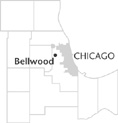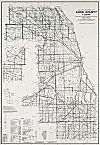| Entries |
| B |
|
Bellwood, IL
|
 Cook County, 13 miles W of the Loop. The suburb of Bellwood is bounded by the Eisenhower
Expressway
to the south, the Proviso yards of the Union Pacific
Railroad
to the north, and the suburbs of
Maywood
to the east and
Hillside
and
Berkeley
to the west. With rail and highway
transportation
readily available, Bellwood developed a strong manufacturing base, yet remains essentially a residential community of single-family houses.
Cook County, 13 miles W of the Loop. The suburb of Bellwood is bounded by the Eisenhower
Expressway
to the south, the Proviso yards of the Union Pacific
Railroad
to the north, and the suburbs of
Maywood
to the east and
Hillside
and
Berkeley
to the west. With rail and highway
transportation
readily available, Bellwood developed a strong manufacturing base, yet remains essentially a residential community of single-family houses.
Consisting primarily of level prairie, the area was mainly farmland until the early 1890s when the first two subdivisions were established. The first subdivision attracted a handful of businesses, including several taverns. Tavern owners were the first to push for incorporation, in response to dry Maywood's attempt to annex the subdivision. The village of Bellwood was incorporated on May 21, 1900, taking the name of a second early subdivision, Bellewood.
Bellwood's population grew steadily between 1900 and 1930. The 1910 population of 943 doubled by 1920 as more people, many of German and Russian descent, moved to the village. The 1926 annexation of land west of Mannheim Road, plus continued migration, accounts for the jump to 4,991 residents in 1930.

|
The 1970s brought racial change to the community—and involvement in a U.S. Supreme Court case. In 1975 the village of Bellwood filed a lawsuit accusing a local real-estate firm of racial steering. Four years later a landmark ruling by the Supreme Court granted municipalities the legal right to use testers and to sue when discrimination occurred. Bellwood's black population grew from 1.1 percent in 1970 to 35 percent in 1980 and to 70 percent in 1990.
Today, several of Bellwood's large manufacturers remain, but the loss of other large industries has caused a decline in employment and in tax dollars. However, a number of smaller industries and commercial enterprises brought some new construction to the village. Like the trees planted in village parkways, Bellwood, with its many brick bungalows, ranches, and Georgians, has matured, but in many respects it remains the largely residential suburb that it has been for the last 50 years.
| Bellwood, IL (inc. 1900) | |||||
| Year |
Total
(and by category) |
Foreign Born | Native with foreign parentage | Males per 100 females | |
| 1930 | 4,991 | 21.1% | 40.3% | 110 | |
| 4,986 | White (99.9%) | ||||
| 5 | Other (0.1%) | ||||
| 1960 | 20,729 | 7.9% | 26.4% | 96 | |
| 20,709 | White (99.9%) | ||||
| 1 | Negro (0.0%) | ||||
| 19 | Other races (0.1%) | ||||
| 1990 | 20,241 | 5.3% | — | 94 | |
| 4,825 | White (23.8%) | ||||
| 14,491 | Black (71.6%) | ||||
| 267 | Asian/Pacific Islander (1.3%) | ||||
| 658 | Other race (3.3%) | ||||
| 1,006 | Hispanic Origin* (5.0%) | ||||
| 2000 | 20,535 | 6.1% | — | 88 | |
| 2,412 | White alone (11.7%) | ||||
| 16,783 | Black or African American alone (81.7%) | ||||
| 49 | American Indian and Alaska Native alone (0.2%) | ||||
| 197 | Asian alone (1.0%) | ||||
| 4 | Native Hawaiian and Other Pacific Islander alone (0.0%) | ||||
| 779 | Some other race alone (3.8%) | ||||
| 311 | Two or more races (1.5%) | ||||
| 1,631 | Hispanic or Latino* (7.9%) | ||||
The Encyclopedia of Chicago © 2004 The Newberry Library. All Rights Reserved. Portions are copyrighted by other institutions and individuals. Additional information on copyright and permissions.